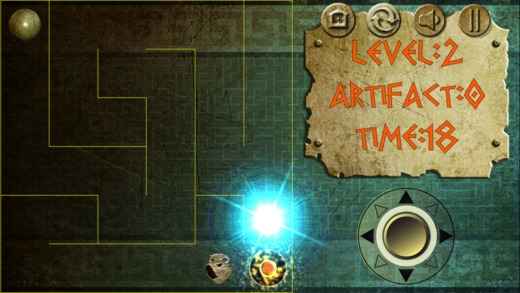Maze / Labyrinth 1.1
Continue to app
Paid Version
Publisher Description
In Greek mythology, the labyrinth (Greek: labyrinthos) was an elaborate structure designed and built by the legendary artificer Daedalus for King Minos of Crete at Knossos. Its function was to hold the Minotaur eventually killed by the hero Theseus. Daedalus had so cunningly made the Labyrinth that he could barely escape it after he built it. A maze is a path or collection of paths, typically from an entrance to a goal. The word is used to refer both to branching tour puzzles through which the solver must find a route, and to simpler non-branching ("unicursal") patterns that lead unambiguously through a convoluted layout to a goal. (The term "labyrinth" is generally synonymous, but also can connote specifically a unicursal pattern.) The pathways and walls in a maze are typically fixed, but puzzles in which the walls and paths can change during the game are also categorised as mazes or tour puzzles. Maze construction Mazes have been built with walls and rooms, with hedges, turf, corn stalks, hay bales, books, paving stones of contrasting colors or designs, and brick, or in fields of crops such as corn or, indeed, maize. Maize mazes can be very large; they are usually only kept for one growing season, so they can be different every year, and are promoted as seasonal tourist attractions. Indoors, Mirror Mazes are another form of maze, in which many of the apparent pathways are imaginary routes seen through multiple reflections in mirrors. Another type of maze consists of a set of rooms linked by doors (so a passageway is just another room in this definition). Players enter at one spot, and exit at another, or the idea may be to reach a certain spot in the maze. Mazes can also be printed or drawn on paper to be followed by a pencil or fingertip. Generating mazes Maze generation is the act of designing the layout of passages and walls within a maze. There are many different approaches to generating mazes, with various maze generation algorithms for building them, either by hand or automatically by computer. There are two main mechanisms used to generate mazes. In "carving passages", one marks out the network of available routes. In building a maze by "adding walls", one lays out a set of obstructions within an open area. Most mazes drawn on paper are done by drawing the walls, with the spaces in between the markings composing the passages. Maze solving is the act of finding a route through the maze from the start to finish. Some maze solving methods are designed to be used inside the maze by a traveler with no prior knowledge of the maze, whereas others are designed to be used by a person or computer program that can see the whole maze at once. The mathematician Leonhard Euler was one of the first to analyze plane mazes mathematically, and in doing so made the first significant contributions to the branch of mathematics known as topology. Solving mazes Mazes containing no loops are known as "standard", or "perfect" mazes, and are equivalent to a tree in graph theory. Thus many maze solving algorithms are closely related to graph theory. Intuitively, if one pulled and stretched out the paths in the maze in the proper way, the result could be made to resemble a tree. What s the difference & what types are there? In dealing with a subject as varied and complex as labyrinths and mazes, it is essential to make definitions that can be clearly explained. The first task is to clarify the difference between a labyrinth and a maze. While the terms are often used interchangeably, many historians and enthusiasts are passionate about which is which. Look up the words in a good dictionary and you will probably conclude that a maze is a labyrinth and a labyrinth is a maze... However, in the English-speaking world it is often considered that to qualify as a maze, a design must have choices in the pathway.
Requires iOS 6.0 or later. Compatible with iPhone, iPad, and iPod touch.
About Maze / Labyrinth
Maze / Labyrinth is a paid app for iOS published in the Action list of apps, part of Games & Entertainment.
The company that develops Maze / Labyrinth is Alexander Bronskov. The latest version released by its developer is 1.1.
To install Maze / Labyrinth on your iOS device, just click the green Continue To App button above to start the installation process. The app is listed on our website since 2016-11-01 and was downloaded 4 times. We have already checked if the download link is safe, however for your own protection we recommend that you scan the downloaded app with your antivirus. Your antivirus may detect the Maze / Labyrinth as malware if the download link is broken.
How to install Maze / Labyrinth on your iOS device:
- Click on the Continue To App button on our website. This will redirect you to the App Store.
- Once the Maze / Labyrinth is shown in the iTunes listing of your iOS device, you can start its download and installation. Tap on the GET button to the right of the app to start downloading it.
- If you are not logged-in the iOS appstore app, you'll be prompted for your your Apple ID and/or password.
- After Maze / Labyrinth is downloaded, you'll see an INSTALL button to the right. Tap on it to start the actual installation of the iOS app.
- Once installation is finished you can tap on the OPEN button to start it. Its icon will also be added to your device home screen.
